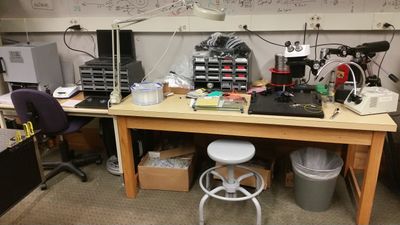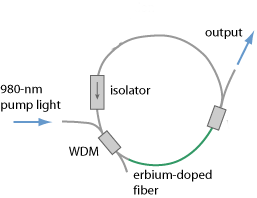Fiber-Optics Obstacle Course
- When working with bare fibers or lasers wear appropriate safety (or laser) goggles. If you're unsure about this please consult the instructor or lab TAs.
Permanent Materials (located at the fiber station):
- Bulk SMF
- Fiber connectors
- Polishing materials (polishing film, disks, fiber stripper, fiber cleaver, inspection scope)
- free-space-to-fiber coupler
- fiber chucks
- 50/50 fiber splitter/combiner
- 90/10 fiber splitter/combiner
- 1550/980nm WDM
- 1550nm fiber isolator
- 980nm pump laser
- Erbium-Doped fiber
Materials to borrow when necessary
- Power Meter
- Fusion Splicer
Activities
- Read the first 4 chapters of John Crisp's eBook, "Introduction to Fiber Optics". Consult remaining chapters as needed.
- Look over the APL's Fiber Optics Wiki page Fiber Optics and links therein.
- Consulting Thorlab's Fiber Polishing Manual Fiber Polishing and Connectorization and the (above mentioned) eBook construct a 1 meter SM FC-APC to FC-APC fiber patch cable (you will find everything you need at the fiber polishing station).
- Measure power loss through your patch cable.
- Break your patch cable in the middle and repair it with a fusion splice (see fusion splicer manual Fusion Splicer Manual and eBook.
- Measure the power loss through your fusion spliced patch cable.
- Break the fusion splice out of the patch cord leaving two partly-connectorized fibers.
- Strip and cleave the unconnectorized end of one of the fibers and use the free-space-to-fiber coupler
to couple a free space beam into the SM fiber (our coupler is not quite as that shown at the right).
- Use a 50/50 fiber splitter/combiner to split your fiber coupled beam into two approximately equal beams. Measure the power in each output beam.
- Use a 1550nm Fiber-coupled LD and a 980 nm fiber-coupled LD and a 1550/980 WDM (wavelength division multiplexer) to combine the 980 and 1550 nm sources into a SM fiber.
- Verify that a fiber isolator exhibits low power loss in one direction only.
- Construct an Erbium-Doped SM Fiber Ring Laser. Measure its optical power vs. pump current/power curve. See here for more details


